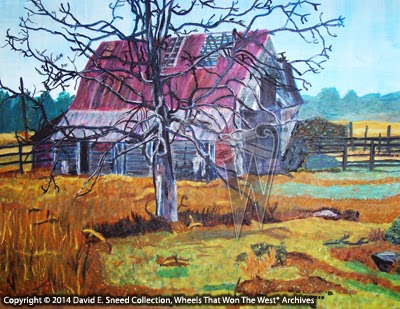Like a lot of folks that grew up on a farm, I’ve spent a fair amountof time working in, on, and around barns. At the time, I didn’t realize the positive memories these places wouldpush deep into my mind. Perhaps it’s becausemost of those wooden frameworks were dusty (and sometimes overly aromatic) insecthavens that were poorly lit, spattered with cobwebs, and insufferably hot –especially in hay season. Even so, fromphotographers and advertisers to publishers and event coordinators, rusticbarns can be a big attraction today. They stand as weather-beaten testimonies of agrarian communities, familyties, fond memories, and sweat-driven dreams. They can be a respite from the wind, a welcome relief from the rain, andthe birthplace of new life.
 |
| Many years ago, my wife captured dad’s old barn on canvas. |
The bigger barns on my dad and granddad’s farms are both gone. Victims of gravity and time, the only placethey exist now is in my mind. I canstill see the corn cribs, mangers, feed rooms, hay drops, and oak plankstalls. I have an old chair rescued fromone family barn and a pair of doors with hand-forged hinges taken from another;special reminders of all-but-forgotten days. Even so, these places from our past hold more than memories. Time marches on and along the way, we’resometimes fortunate to find and recover things that bring us closer to our pastand, just maybe, a bit closer to remembering who we are and where we’ve comefrom. Such was the case, when the newowner of an old bank barn happened upon a forgotten treasure.
 |
| Bank barns allow ground level access to the structure from two different levels. |
Bank barns are amazing structures and the state of Pennsylvania isfull of them. Perched on the side of aknoll or hill, many have stood for generations. Some remain in use while others sit empty, relegated to service as acultural landmark of sorts. Still othersharbor countless relics from days gone by. It’s this category that best defines a particular barn I learned ofearlier this year. It’s located near theSusquehanna River in Pennsylvania. For some, it may have appeared to be just another outbuilding. Decade after decade, though, it quietly helda secret. A secret tied to anotherplace, another time, and another life.
When I first set my eyes on the barn, it was sagging in places and clearlyshowing its age. No longer could it keepthe wind and rain as much at bay. Itjust wasn’t as strong as it once was. Yet, in some ways, the character it holds today makes it even moreattractive; enough so that, by the summer of 2014, the owner was determined tohelp get the building back in a better state of repair. Old hay was removed. Ages of clutter, discarded implement parts,old wheels, rusted wire, window frames, and other debris were gonethrough. As he shared his story, theowner said he had been working in a side shed attached to the barn and noticedsome planks stored above the log rafters. Climbing up to examine the boards, the dim light revealed somethingmore to him. Next to the rough sawn lumber werethe isolated remains of a Conestoga wagon bed. The heavy pair of sideboards were carefully removed and brought out intothe daylight. They were covered in dustas well as a century’s worth of animal droppings and other debris. The exteriors of both panels appeared to becoated with white paint. We’re told thata good part of this light coloring washed away when a garden hose was used to cleanthe boards. After looking at thesideboards firsthand, I’m convinced that this white tone was likely theoriginal blue pigment that had heavily oxidized, essentially turning topowder. Fortunately, enough blue leadwas firmly stuck to the wood that limited amounts can still be seen in someareas, including sections on and around the tool box.
 |
| These early sideboards were part of a mid-sized Conestoga wagon. |
In addition to the blue paint, we found the initials – I. K. – stampedinto the largest metal band surrounding the tool box. Eight sets of bow clips line each side. Handforged ironing, lock chains, and hasps designed to hold the box to the gear areall substantially intact. The sideboardscurve upward and stretch 13 feet in length at the top and 11 ½ feet at thebottom. They measure a full 3 feet indepth at the ends with the center section narrowing to 27 ½ inches.
In classic Conestoga styling, the side panels are formed by threelongitudinal rails intersected by upright, chamfered standards mortised throughthe rails. This particular design isengineered to allow the sides, ends, and bottom to be separated or knocked downfor shipment, storage, or other uses.
We’ll need more time to determine if additional provenance can be found. All in all, though, it’s just thekind of pre-Civil War wagon discovery that reminds us it’s still possible to find substantially original, early 19th century pieces. While true barn finds have become a rarity these days, patience and persistence have a way of opening doors we might otherwise pass by. The old bank barn may be weathered and tired but it has done its job – delivering some of America’s rarest transportation history to a place of respect and preservation in the 21st century. 